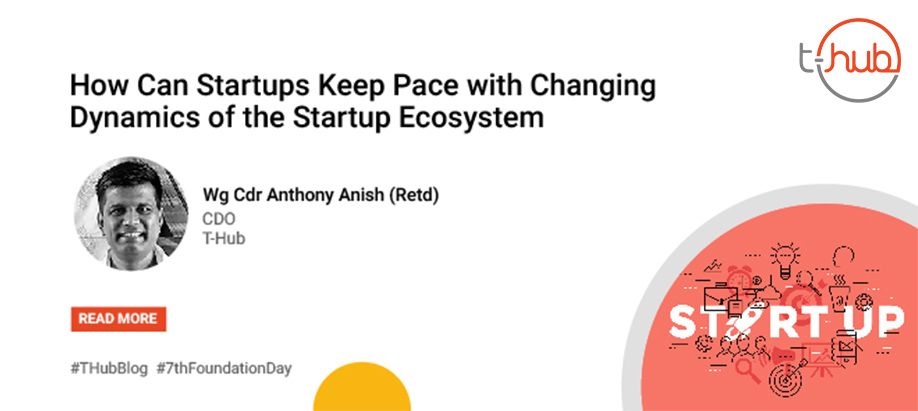The idea of this blog is to bring out some of the insights shared by industry experts during the recent Corporate Innovation roundtable anchored by T-Hub.
Financial inclusion – Financial Inclusion is described as the method of offering banking and financial solutions and services to every individual in the society without any form of discrimination. It primarily aims to include everybody in society by giving them basic financial services.
Financial inclusion chiefly focuses on providing reliable financial solutions to the economically underprivileged sections of the society without having any unfair treatment, without any signs of inequality and is also committed to being transparent while offering financial assistance without any hidden transactions or costs.
There are two aspects to this concept: Finance and inclusion. Often times we spend time on the Finance piece and thus we should also spend equal time on the inclusion piece.
Financial Inclusion if you think about it, it’s not a new topic as there are several corporates who work on financial inclusion and the RBI itself has programs on it. Under Digital India we see the Government of India introduced several initiatives starting with the –
- India stack
- The jam Trinity
- UPI which was a huge step in promoting electronic payments.
- E-governance
- E-Kranthi – to ensure that appropriate governance on digital finance
Do we really understand the problem or its enormity? If we look at India through the pink income pyramid which is a classic Indian income model based on the household income –
- 23% of India earns more than >$10/day
- 30% population of India earns less than <$2/day
- 800 – 900 million Indians see DBT(Direct Benefit Transfer) in one or other form
- 500 million mobile devices out which 300-350 million unique users
Surprisingly most of the Indians still run some feature phones (50 to 55%) And yet many people still don’t have a phone they may have access to the home landline but they don’t have because of societal reasons.
Financial inclusion efforts derailment to Productitis? –
Financial literacy many a time it’s sort of a go-to solution for a lot of people with regards to initiatives under financial inclusion. India not great with data and there have been billions of dollars spent on financial literacy, while it’s has proven – that it does not work
Our extreme focus on technology, to give credit where it’s due – it’s awesome, our efforts in the India stack story, We are obsessed with technology, drawing these from our conversations and discussions. They’re all about technology.
The assumption – that if we build the right technology it will be good for low-income people is dangerous and just plain wrong. We see a similar sort of trend around products, we believe that since the industry operates in sort of the inner product world, our measurements are around increasing access and usage of those financial products.
We all know inclusion would be good for low-income people, the biggest risk that we face right now is just the obsession with products. We call it productitis and technology. we should see technology as a means to an end. And that end is improving the financial lives of low-income people.
The first step is to understand what it means – Financial Inclusion has a relatively simpler definition – are people financially healthy or not? And are we able to use those technologies, yet products and solutions to improve their financial lives? As simple as that!
It begins with that sort of intent and, and sort of outcome in sight, the first step is to have that clarity of outcome and once we have that then the policymakers can look at gaps then fintech can sort of understand what to focus on and we can invest in the right areas.
The curious case of non-adoption of the existing fintech infrastructure-
Understanding all pain points of customers and getting the entire perspective is key. Unless we understand what is the problem being solved, the problem that people are facing due to which they are not able to use the products and services which are available despite having a robust and powerful India stack. We don’t try to solve hard problems and are more likely to tackle easier problems and challenges.
- Why the insurance penetration rate in single digits?
- Why only 15% of people depend on the formal source of credit and the rest rely on informal credit or don’t have access to credit?
- Why do 90% of micro and small enterprises don’t have access to any formal credit?
70% of India is actually living at around under $10 a day and that’s the reality, but we are not actually designing process or solution, we are not designing an approach to solutions for a segment which is not yet on the smartphone, then they may be smartphone heavy but hesitant to use it for financial transactions, lack of comfort in this regard is the common barriers to adoption despite having the infrastructure essentially at their fingertips.
With regards to ascertaining use cases for what drives people to adopt a certain product or service unless we are able to deliver it from the value perspective, how can it be delivered effectively? so that it addresses the barriers to adoption-
- Product/service knowledge
- Confidence to adopt solutions
- Comfort and Convenience in using product/service through the interface
- Trust the system/institution facilitating financial services
- Affordability and accessibility
So unless all of these multiple challenges of affordability, access, trust, Knowledge, convenience, only then adoption is not likely to occur.
Microfinance and impact investing-
Microfinance as an instrument which has gotten developed and evolved over a period of time has gone through a lot of iterations and a very concentrated approach to reach where it is today. To understand how can a poor person return the money when the repayment rates are phenomenal and therefore a lot of nuances exists just to understand that social collateral
And from a venture capital standpoint, any impact investor or venture investor wants some degree of replicability,
The impact does not necessarily have to come at the cost of return. If one is able to and is willing to go and take risks to go to underserved markets one can create both a very large impact and create attractive returns as well.
microfinance is one of the standing examples when we talk about Core financial inclusion. where people have got an impact and returns as well. But so many other models where people have really tried to, for even microfinance companies wanted to do enterprise lending.
The DNA of the organization wasn’t supporting that kind of lending. They were trying to create business verticals. But it was a matter of not just creating a business vertical and assigning designations to people but rather the changes to the whole operational mechanisms.
A bank and microfinance is a very different way of operating – the loan officer of a bank versus a loan officer of microfinance have a completely distinct loan origination process
And those nuances, the meat is really in those details.
On the MSME side, a lot of very interesting companies have come in with a very razor-sharp focus as they’ve identified how to optimize their loan origination and how to do their credit underwriting etc.
Although they are impact investors, they possess very commercial kinds of terms with investors, these are all defined term funds. Patient capital is not necessarily that patient, because they need their exits. And that actually leads to a lot of models which may look good from a long term vision standpoint.
But if there is any sort of discomforting factor vis-a-vis, six-year seven-year horizon,
questions like -where will this company reach? Can we get a good exit? impedes the impact investment community in taking those kinds of calls.
Startup perspective –
One key objective is to nurture innovative startups in the space of savings, investments, payments and lending. The problem or the challenge is that like most real-world problems, especially in the social development space – financial inclusion is not one of those things that is a single-dimensional linear challenge, It’s nonlinear and multidimensional in nature.
We often forget in our zest and zeal to improve things that we are also dealing with a very delicate social fabric which is an important and notable aspect. The message from that story is – It’s important that we, in whatever we do, preserve that social fabric. We have to be adopting a holistic approach, it cannot be piecemeal. It has to be Inclusive to all the stakeholders.
Startups probably somewhere in their value chain in the life cycle, need to tie up with a financial institution for their patronization as a vendor or partner or as an associate, because they themselves do not have the license with them to be able to start experimenting with their idea straight away.
One is about ideas which are technology-based and that will help a banking or a financial institution to increase their operational efficiency.
The second category, more relevant to the financial inclusion side are ideas which help in market penetration or reaching out to the unserved market, which needs to have a physical outreach component.
Bringing in new products and services, which are most suited to small ticket size people and these are different from the custom products that are already there in the market. Due to the absence of a license, they would need the support of a financial institution before taking that idea/experiment/product to the market.
Only through the involvement of the top management of any financial institution would allow them to see the value that a startup can bring to a bank or to its financial institution. And therefore people who are in the visionary group of the leadership group need to be actively involved in collaboration with startups.
Concluding thoughts –
- We need to realize that this is not a problem which has a single solution. We need to change our mindset in terms of what we are providing. Therefore there arises a need to provide the right solutions at the right places at the right price points and need to think about these factors before designing or delivering solutions.
- Need to look at what people need as part of a broader financial wellbeing and health standpoint and need to broaden our thinking and our canvas to look at something long term and sustainable.
- To put customers’ financial health at the centre of business, it may be referred to as customer-centricity, which begins with understanding and measuring.
- Having a clear set of goals around which one can contribute to improving and then support, develop, test and scale the right solution.
- Customer acquisition costs– while they may want to have inclusion, It is certainly is a cost which needs to be borne by someone and therefore centralization certainly matters
- Suitability of products– There has been a lot of mis-selling, in the broking and insurance industry which may have created the trust deficit alluded to before. The suitability of the product for that particular category needs to be looked at from bottom up.
- Innovation front– yeah, there are a lot of sandboxes, which are being talked about by IRDA and RBI. In fact, t -hub is partnering with the Government of Telangana have made requests to both these regulators and have exhibited a willingness to partner in that.
- leveraging partnerships is going to be critical, these partnerships will play a long term role as well as a short term role. It’s Important to know, whoever wants to build to a serious scale that there is money to be made out there at every level.
- To just collaborate, collaborate and collaborate, to ultimately create templates that can be then replicated across multiple geographies and have an impact at scale.
- Formalized Financial Literacy even at the school level
- De-centralization of corporate innovation hubs
- Regulatory deferment for startups in the initial period of creation.
The idea about local entrepreneurship creation which essentially is rooted in the ground-up manner and is created from the point where it was needed the most. Financial literacy, how it can be built in a different manner and can be a 2.0 version of the manner in which it has been essentially built for over a period of years. And To look at the piece on design thinking, which becomes extremely important from the point of view of when we take solutions from urban India to rural and the thinking of rural customers first. It is an opportune time to take innovation to the next level.
Financial inclusion can make its way if people start taking financial decisions in a better way.
Financial inclusion in terms of creating job opportunities as well as creating entrepreneurship opportunities in the country as opposed to the older narrative of offering people careers.
“Give a man a fish and you feed him for a day. Teach him how to fish and you feed him for a lifetime”
– Lao Tzu
We at T-Hub, power Corporate Innovation through high-impact partnerships and transform your business models for the better. Know more here.






